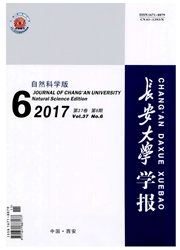

 中文摘要:
中文摘要:
为综合评价城市轨道交通枢纽的客运供给能力与枢纽换乘需求之间的供需平衡,根据分形理论,提出了半径维数、网格信息维数和枢纽关联维数;采用这3种分形维数,对城市轨道交通枢纽的客运供给能力分布以及枢纽的换乘需求分布进行了量化,进而提出了一致性指数与分形综合指数,对城市轨道交通枢纽的换乘供需平衡问题进行了评价;最后以北京市轨道交通线网为例,验证了方法的有效性。研究结果表明:半径维数代表了枢纽换乘供需从城市中心向周边的分布变化趋势,网格维数代表了枢纽换乘供需在空间分布的均衡性,枢纽关联维数代表了轨道线网各枢纽之间的通达性;分形一致性指数与分形综合指数则分别从单一方面与整体上评价了供给能力与换乘需求之间的供需平衡;研究为城市轨道交通线网及枢纽的规划与后评价提供了有益参考。
 英文摘要:
英文摘要:
Based on the fractal theory, this research adopted the radius fractal dimension, grids informa- tion fractal dimension and terminal relation fractal dimension for the comprehensive evaluation of the bal- ance of supply capacity and transfer demand of urban rail transit terminals. With the above three fractal dimensions, the research made quantitative analysis on the distribution of transportation supply capacity and transfer demand of urban rail transit terminals. Then the consistency index and comprehensive con- sistency index were introduced for the evaluation of the balance of supply and demand for urban rail tran- sit terminals. Taking rail transit network of Beijing as an example, this article verified the validation of the model and algorithm. The results show that the radius fractal dimension represents the change trend from the city core to the periphery of transfer supply and demand of rail transit network, grids informa- tion fractal dimension represents the balance of spatial distribution of the transfer supply and demand and terminal relation fractal dimension represents the accessibility of terminals. The consistency index and comprehensive consistency index have represented the balance of supply capacity and transfer demand from different aspects. The research results can provide a useful reference for the application of the study on planning and post evaluation for urban rail transit network and terminals. 4 tabs, 5 figs, 16 refs.
 同期刊论文项目
同期刊论文项目
 同项目期刊论文
同项目期刊论文
 期刊信息
期刊信息
